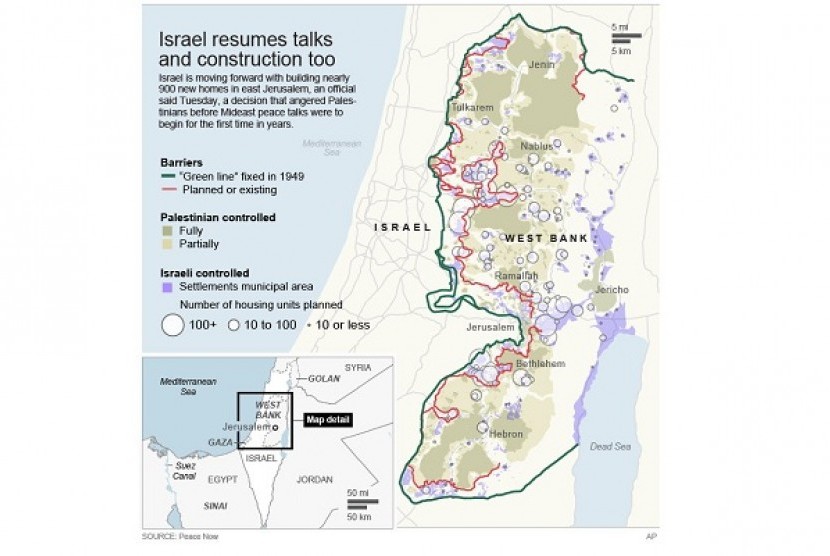REPUBLIKA.CO.ID, JERUSALEM - Since Abbas and Olmert last met in 2008, the situation has become even more complex. Netanyahu has rejected Israel's pre-1967 frontier as a starting point for border talks and says east Jerusalem is not up for discussion.
There are also more settlers: The number of Israelis living in the West Bank and east Jerusalem has increased from 489,000 five years ago to around 530,000 in 2011, according to government figures. Settler officials recently put the current total at 568,000.
The Netanyahu government says it is largely building in east Jerusalem and West Bank "settlement blocs" it intends to keep — although is doubtful the Palestinians would sign off on such a map. And the Israeli anti-settlement group Peace Now says that under Netanyahu, more than one-third of settlement housing starts were deep inside the West Bank.
In a swap deal that falls somewhere between Abbas' and Olmert's proposals, well over 100,000 Israeli settlers would have to leave their homes. Some in Israel warned that at the current rate of building, partition will soon be physically impossible.
Jerusalem expert Daniel Seidemann pointed to unilateral Israeli changes in the eastern sector of the city, sought by the Palestinians as a capital, in the past five years. Israel has significantly expanded its settlement there, effectively dictating the eventual borders — if the city is to be divided along ethnic lines, as the U.S. has proposed.
The foothold of Jewish settlers in east Jerusalem's so-called holy basin, the area around major shrines of Judaism, Islam and Christianity, has "increased exponentially over the past five years," Seidemann warned.
Meanwhile, the upheaval in Arab countries next door — civil war in Syria and Egypt's revolution and military coup — is bound to harden Israel's security demands of a future Palestine. Israel's main concern is that the West Bank, which is currently relatively stable, could follow the path of the Gaza Strip and become a launching ground for rocket attacks. Israel pulled out of Gaza in 2005, and Hamas militants seized power there two years later.
Netanyahu's office has said Israel will insist on an Israeli presence in the Jordan Valley and border controls that prevent an infiltration of militants. "The volatility, violence and instability we have seen over the last two years only strengthened the determination" to obtain solid security arrangements, Regev said.
For Palestinians, that's a nonstarter. In previous rounds, they agreed to a demilitarized state and Israeli air force overflights and proposed that U.S.-led NATO troops patrol the border, but rejected continued Israeli control in the Jordan Valley.
Shaul Arieli, a former Israeli negotiator, said Abbas and Olmert had narrowed their gaps on a security deal, adding that of all the disputes on the table, "it was the easiest issue to agree on."
Netanyahu adopted a difference stance, said Abbas aide Yasser Abed Rabbo. He said that Molcho, the Netanyahu envoy, told him two years ago that Israel wants to lease the Jordan Valley for 40 years and set up military bases there.
"And as we know, they would ask for secured roads to these military bases, and secured areas around these roads which make most of the area under their control," Abed Rabbo said.


